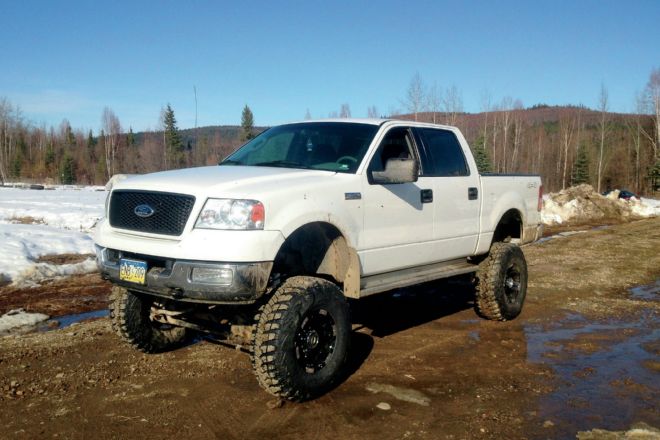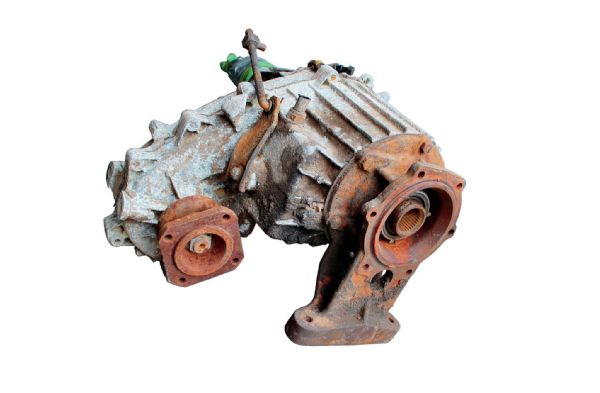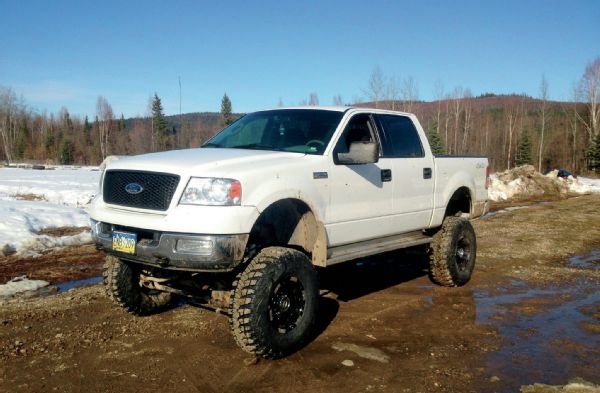
Jumping Out of Gear
Q I have an ’87 Chevy 1⁄2-ton with a 350ci engine and a 700-R4 transmission. It jumps out of gear in 2-Hi. If I put it in 4-Lo and drive a little ways, then put it back in 2-Hi again, it will move for about a mile then jump out again. I recently put new lockers in the front, but it seems to be getting worse. Could this be the transmission or the transfer case? Also, could you tell me what transfer case should be in this truck? Any info would be great, as I’d like to get the truck back on the road.
Dwight
Via nuts@4wheeloffroad.com

A Either the transmission or the transfer case could be the culprit, but I would focus on the transfer case based on the symptoms you describe. Your truck should be equipped with an NP208 transfer case, which is a pretty decent case that sometimes gets a bad rap. It has an aluminum housing and is chain drive, meaning that the front output is driven by a chain inside the transfer case rather than gears. The NP208 is not as strong as the NP205 and NP203 that it replaced, but it is a pretty stout unit for mild to moderate off-road use. Its Achilles heel is the rear slip yoke, which tends to break under hard use.
My reason for focusing on the transfer case is because you mention that it pops out in 2-Hi but works fine in 4-Low, which indicates that the transmission is sending power downstream. Step one is making sure that the transfer case shift linkage isn’t damaged and is properly adjusted. To do this, disconnect the linkage at the case and manually shift the lever on the case into each range (2-Hi, 4-Hi, Neutral, and 4-Low), and compare it to the linkage’s position when you shift the lever on the floor into each range. If it’s adjusted properly, then the linkage should line up with the lever on the case in each range. If not, try adjusting it and see if that helps. Also make sure that nothing is interfering with the shift lever in the 2-Hi position, such as the shifter boot, floorpan, or the shifter’s indicator housing. Keep in mind that you should do this on flat ground with the tires chocked so that you don’t accidentally run yourself over.
If the linkage checks out, then most likely the problem is internal. Jumping out of gear could be caused by a bent shift fork or worn out internals. The only way to know for sure is to pull the transfer case and tear it down for inspection. At that point, it might be just as easy to source another transfer case. NP208s are extremely common in junkyards, and rebuilt ones can be sourced from many different places, but be aware that the NP208 in your truck has a 27-spine output shaft, while NP208s behind TH400 transmissions have a 30-spline input. Lastly, it’s doubtful that your recently installed locking hubs (or locking differential, depending on what you mean) are the culprit.
Swapped Axles = Check Engine, Part 2
Q In reference to Brian McManus’ question regarding swapping F-350 axles into his F-150 (“Swapped Axles = Check Engine,” Nuts & Bolts, July ’14), I had a similar problem to this when I lifted, regeared and put larger tires on my ’07 F-350. While my reasoning behind the fix may be completely off, the solution still worked.

To my understanding, the tone ring on Fords is not used to determine speed, or at least not directly. The two tone rings on the front axle (ABS sensors) and one on the rear are used to determine differences in wheel speed between each other and the measured speed from the sensor in the transfer case (it may be in the transmission; it has been a while since I’ve looked). The reason for the three tone rings is the three-channel ABS. When you regear the axle, the expected speed from any of the tone rings does not match the speed being sent to the speedometer from the transfer case. This is what triggers the check engine light.
Now for the solution. In my case it was a Superlift TruSpeed. This modifies the signal sent from the transfer case to coincide with the correct vehicle speed and also match the tone rings. There are many products that do the same thing. I chose the TruSpeed because that is all it does, and simple things are less likely to malfunction. Plus, it varies the signal mechanically by adjusting the voltage, not in the computer programming. Again, simple things are less likely to break. I hope this helps Brian. Keep up the good work.
John S.
Via nuts@4wheeloffroad.com
A Thanks for the tip! This is a potential solution to McManus’ dilemma, but your problem and his problem may be two different things. In his case, he swapped the axles from a Super Duty like yours into an F-150, and it was unclear whether he attempted to make the Super Duty tone ring sensors work with the F-150 computer, or if he adapted the F-150 sensors to the Super Duty axles. As a result, he may be potentially fighting incompatible sensors and computers, while your problem stemmed from the sensors reading inaccurately due to the gear swap. I also agree with your basic assessment of how the factory vehicle systems work and why they aren’t happy, though our understanding would likely make any Ford engineer cringe.
You and I are also in complete agreement that installing something like the Superlift TruSpeed (800.551.4955, superlift.com) is a potential solution. The TruSpeed is a little black box that allows the user to adjust the signal waves or pulses (not the voltage) coming from the sensors on the axles to compensate for larger tires or gear swaps. With the turn of a dial, the user can speed the signal waves up or slow them down. It’s an extremely handy little device that is simple and effective when it is wired up and adjusted properly. Sadly, it appears that Superlift is no longer offering the TruSpeed, but a lot of them were sold over the years and they are still out there. But as you mentioned, there are several programmers available that can do the same thing, even if they don’t offer the very fine and largely mechanical tuning that the TruSpeed does.
As we told McManus, his best bet is finding a high-powered scanner that has the ability to do data logging to see the real source of the truck’s issues, but since there may not be many of those available in remote Alaska where he lives, your suggestion is certainly worth a shot.
Saggy Springs
Q I have a ’98 Ranger with an ’85 Chevy Dana 44 high-pinion front axle, chromoly axleshafts, Warn hubs, and an ARB Air Locker with 4.88 gears that is pushing 37-inch tires with beadlock wheels. The problem I’m having is the driver-side front of my rig has always sagged 2 inches more than the rest of my truck, and in fact I’ve broken a Rubicon Express leaf spring on that side once already. I’ve replaced the spring and it brought it all up to level for a while, but now it sags again. This becomes a problem when I’m wheeling because it bottoms out on the trail. Could it be the shocks, which are rancho 9000s, or something completely different?
Darren M.
Via nuts@4wheeloffroad.com

A I’m guessing that your truck’s donor axle came out of an earlier Ford truck rather than an ’85 Chevy, as Chevy truck front axles were all low-pinion and had a differential offset to the passenger side, and Chevy front axles around that vintage were all 10-bolts rather than Dana 44s—but that’s mostly irrelevant to your question.
It’s doubtful that the front shocks are causing the issue, because if they were too short or too long, you would likely be breaking shocks or shock mounts rather than leaf springs. It also seems odd that the truck consistently sags to the driver side, so the first step is making sure that the frame is straight and that the cab and body bushings are in good shape. Also make sure that the leaf spring mounts that you fabricated are square and that they are the proper distance apart to work with the leaf springs. You didn’t mention what leaf springs you used with the front axle conversion, but the popular options are front springs from either a Jeep Wrangler YJ or a fullsize Wagoneer. I would suspect that the YJ springs have a spring rate that’s a little lighter than what you would need for a Ranger in order to maintain proper ride height long-term, especially if you’re using your Ranger off-road a lot. If you are using YJ springs, then I would try adding a leaf or two to the spring pack in order to beef up the spring rate. This will take some trial and error, but you should be able to find a proper balance of flex for the trail and spring longevity. If you are using Wagoneer springs, then if anything they spring rate should be a little heavy for your Ranger.
Another important but often overlooked part of a conversion such as yours is bumpstop placement. Your truck’s front suspension needs properly placed bumpstops not just to keep the tires out of the fenders but also to avoid overworking the leaf springs. Lift springs don’t like to be forced into a negative arch, and if your front suspension setup doesn’t have bumpstops in the right spots, it will force the springs to work beyond their designed operating range when under heavy articulation. If this goes on long enough, it will lead to spring fatigue and eventual sagging or even failure. Since it sounds like you are using your truck to do a lot of trail work (good for you!), this could be why your springs are sagging out prematurely. This doesn’t completely explain why just one side is sagging out, but soft springs combined with poorly placed bumpstops could cause what you are experiencing. The next time you get your truck twisted up, hop out and look to make sure the bumpstops are making contact when they are supposed to, before the tires get into the fenders and before the springs are forced into a severe negative arch.
Nuts, I’m Confused
Strut Stuff
Q I have an ’07 Toyota Tacoma and need to replace the struts, so I thought that while I was there I would upgrade to a set of aftermarket struts that provide a little lift. The instructions say I need to use a strut compressor for installation, but is that really necessary? I have some coil-spring compressors, and it doesn’t look like there could be all that much pressure in the coil when the strut is fully extended. I live in a remote area so shops with strut compressors aren’t exactly on every corner. Thanks in advance.
Ben C.
Via nuts@4wheeloffroad.com
A You need a strut compressor. There’s nothing like having the right tool for the job. You would be surprised at the amount of tension stored in a set of struts for your truck, even when the strut is fully extended. Is it possible to do it without? Maybe, but is it worth potentially hurting yourself to find out? Even if you manage to get the strut apart safely, properly orienting the strut plate will be nearly impossible during assembly, and it’s not a good idea to use the center nut of the strut to tighten down the assembly. If you take the struts off the truck and bring them to a shop with a proper strut compressor, they shouldn’t charge you much for disassembly and reassembly. If they’re nice, they can even do it while you wait. It’s insurance against injury, not to mention just being smart.
Submission Information
Confused? Email your questions about trucks, 4x4s, and off-roading tech using “Nuts, I’m confused” as the subject and include a picture (if it’s applicable). Digital photos must measure no less than 1600 x 1200 pixels (or two megapixels) and be saved as a TIFF, an EPS, or a maximum-quality JPEG file. Also, I’ll be checking the forums on our website (4wheeloffroad.com), and if I see a question that I think more of you might want to have answered, I’ll print that as well. Otherwise drop it old-school style with the envelope addressed to the address below. Letters published in this magazine reflect the opinions of the writers, and we reserve the right to edit letters for clarity, brevity, or other purposes. Write to: Nuts & Bolts, 4-Wheel & Off-Road, 831 S. Douglas St., El Segundo, CA 90245 fax to: 818.566.8501 Email to: nuts@4wheeloffroad.com